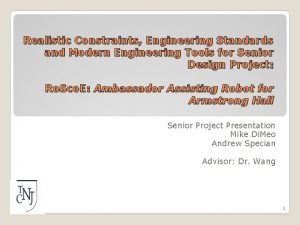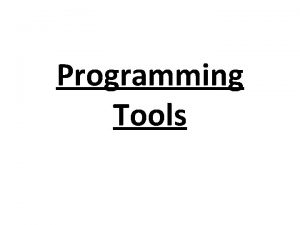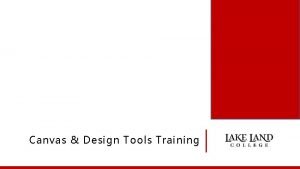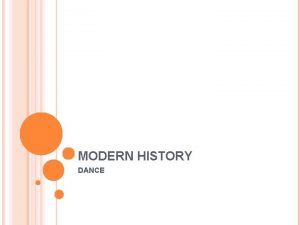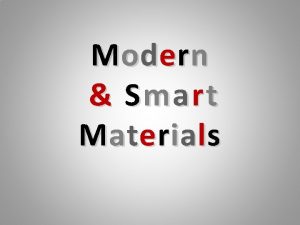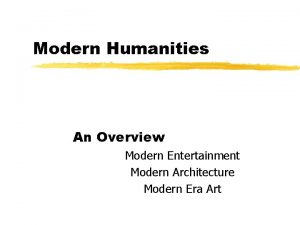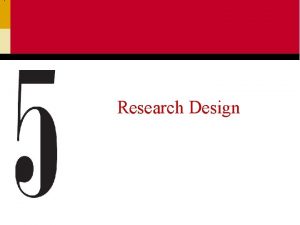RESEARCH RESEARCH DESIGN MODERN TOOLS FOR RESEARCH 1













- Slides: 13

RESEARCH, RESEARCH DESIGN & MODERN TOOLS FOR RESEARCH 1

Learning Outcomes After the study of this topic students must be able to; 1. Analyze the research process 2. Apply the knowledge of Pharmacy in Research process. 3. Use different modern tools in research process & their overall development. 2

PROCESS OF DESIGNING AND CONDUCTING A RESEARCH PROJECT: – What--What was studied? 1. Introduction, Research Problems/ – What about--What aspects of Objectives, & the subject were studied? Justification – What for--What is/was the significance of the study? – What did prior lit. /research say? – What was done--How was the study conducted? – What was found? – So what? – What now? 2. Literature Review 3. Methodology (Research sample, data collection, measurement, data analysis) 4. Results & Discussion 5. Implications 6. Conclusions and Recommendations for Future Research 3

RESEARCH DESIGN Ø RESEARCH DESIGN refers to the plan, structure, and strategy of research--the blueprint that will guide the research process. 4

RESEARCH DESIGN: The blueprint/roadmap that will guide the research. The test for the quality of a study’s research design is the study’s conclusion validity. Ø CONCLUSION VALIDITY refers to the extent of researcher’s ability to draw accurate conclusions from the research. That is, the degree of a study’s: a) Internal Validity—correctness of conclusions regarding the relationships among variables examined u Whether the research findings accurately reflect how the research variables are really connected to each other. b) External Validity –Generalizability of the findings to the intended/appropriate population/setting 5 u Whether appropriate subjects were selected for conducting the study

RESEARCH DESIGN How do you achieve internal and external validity (i. e. , conclusion validity)? Ø By effectively controlling 3 types of variances: • Variance of the INDEPENDENT & DEPENDENT variables (Systematic Variance) • Variability of potential NUISANCE/EXTRANEOUS/ CONFOUNDING variables (Confounding Variance) • Variance attributable to ERROR IN MEASUREMENT (Error Variance). How? 6

Effective Research Design Ø Guiding principle for effective control of variances (and, thus, effective research design) is: The MAXMINCON Principle – MAXimize Systematic Variance – MINimize Error Variance – CONtrol Variance of Nuisance/Extraneous/ Exogenous/Confounding variables 7

Effective Research Design MAXimizing Systematic Variance: Widening the range of values of research variables. Ø IN EXPERIMENTS? – Ø Proper manipulation of experimental conditions to ensure high variability in indep. var. IN NON-EXPERIMENTAL STUDIES? – Appropriate subject selection (selecting subjects that are sufficiently different with respect to the study’s main var. )--avoid Range Restriction 8

Effective Research Design MINimizing Error Variance (measurement error): Minimizing the part of variability in scores that is caused by error in measurement. Ø Ø Sources of error variance: – Poorly designed measurement instruments (instrumentation error) – Error emanating from study subjects (e. g. , response error) – Contextual factors that reduce a sound/accurate measurement instrument’s capacity to measure accurately. How to Minimize Error Variance? – Increase validity and reliability of measurement instruments. – Measure variables under as ideal conditions as possible. 9

Effective Research Design ØCONtrolling Variance of Confounding/Nuisance Variables: FIRST, what are Nuisance/Confounding Variables? May or may not be of primary interest to the researcher, ü But, can produce undesirable variation in the study's dependent variable, and cause misleading or weird results ü Thus, if not controlled, can contaminate/distort the true relationship(s) between the independent and dependent variable(s) of interest ü 10

BASIC DESIGNS SPECIFIC TYPES OF RESEARCH DESIGN BASIC RESEARCH DESIGNS: u Experimental Designs: – True Experimental Studies – Pre-experimental Studies – Quasi-Experimental Studies u Non-Experimental Designs: – Expost Facto/Correlational Studies 11

Questions or Comments ? 12

THANK YOU 13
 Realistic constraints
Realistic constraints Modern development tools
Modern development tools Fspos vägledning för kontinuitetshantering
Fspos vägledning för kontinuitetshantering Novell typiska drag
Novell typiska drag Tack för att ni lyssnade bild
Tack för att ni lyssnade bild Vad står k.r.å.k.a.n för
Vad står k.r.å.k.a.n för Varför kallas perioden 1918-1939 för mellankrigstiden?
Varför kallas perioden 1918-1939 för mellankrigstiden? En lathund för arbete med kontinuitetshantering
En lathund för arbete med kontinuitetshantering Personalliggare bygg undantag
Personalliggare bygg undantag Tidböcker
Tidböcker Anatomi organ reproduksi
Anatomi organ reproduksi Vad är densitet
Vad är densitet Datorkunskap för nybörjare
Datorkunskap för nybörjare Tack för att ni lyssnade bild
Tack för att ni lyssnade bild
